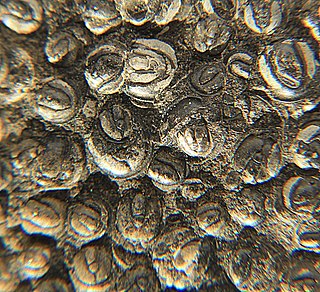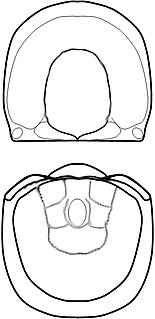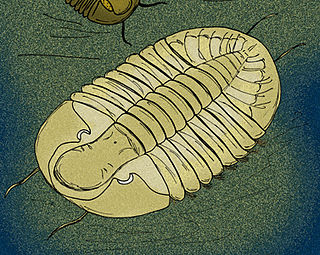
Trilobites are a group of extinct marine artiopodan arthropods that form the class Trilobita. Trilobites form one of the earliest-known groups of arthropods. The first appearance of trilobites in the fossil record defines the base of the Atdabanian stage of the Early Cambrian period, and they flourished throughout the lower Paleozoic before slipping into a long decline, when, during the Devonian, all trilobite orders except the Proetida died out. The last extant trilobites finally disappeared in the mass extinction at the end of the Permian about 252 million years ago. Trilobites were among the most successful of all early animals, existing in oceans for almost 300 million years.

Dalmanites is a genus of trilobite in the order Phacopida. They lived from the Late Ordovician to Middle Devonian.

Agnostus, is a genus of agnostid trilobite belonging to the Family Agnostidae, that lived during the late Middle Cambrian – early Upper Cambrian. It is the type genus of the family Agnostidae and is subdivided into two subgenera, Agnostus and Homagnostus.

Pytine is an extinct genus of asaphid trilobites. Species lived during the later part of the Arenig stage of the Ordovician Period, approximately 478 to 471 million years ago. Various species are found in the Svalbard, Valhallfonna Formation, Olenidsletta, Member, of Spitzbergen, Norway, the Megistaspis (Paramegistaspis) planilimbata Zone of the 'Shumardia Shale' of Sweden, Jujuy Province, Argentina, early Arenig-aged strata of Jiangxi province, China, and Darriwilian-aged strata in Western Hunan province, China. The type species, P. graia, has seven thorax segments, and lacks the rapier-like glabellar spine, that occurs in many other raphiophorids. The Chinese species, by contrast, have only six thoracic segments. So far, only the type species, and one of the Chinese species, P. laevigata, are known from complete specimens.

Lonchodomas is a genus of trilobites, that lived during the Ordovician. It was eyeless, like all raphiophorids, and had a long straight sword-like frontal spine, that gradually transforms into the relatively long glabella. Both the glabellar spine and the backward directed genal spines are subquadrate in section. Lonchodomas has five thorax segments and the pleural area of the pygidium has two narrow furrows. Lonchodomas occurred in what are today Argentina, Canada (Newfoundland), Estonia, Latvia, Norway, Sweden, the Russian Federation and the United States.

Mesonacis is an extinct genus of trilobite that lived during the Botomian, found in North-America, and the United Kingdom. Some of the species now regarded part of Mesonacis, have previously been assigned to Angustolenellus or Olenellus (Angustolenellus). Angustolenellus is now regarded a junior synonym of Mesonacis.
Acmarhachis is a genus of trilobite in the order Agnostida, which lived in what are now Australia, Canada, China (Anhui), Kazakhstan, Russia (Kharaulakh), and the US. It was described by Resser in 1938, and the type species is Acmarhachis typicalis.

Phalagnostus is a genus of small trilobites, in the order Agnostida. It lived during the Middle Cambrian, in what are now Canada, China, the Czech Republic, Denmark, England, France, the Russian Federation, Wales, Sweden, and possibly the United States (Vermont). The headshield is almost entirely effaced and wider than the tailshield. The pygidium is also very effaced, but the ovate pygidial axis is well defined and a border furrow is also present.

Trinodus is a very small to small blind trilobite, a well known group of extinct marine arthropods, which lived during the Ordovician, in what are now the Yukon Territories, Virginia, Italy, Czech Republic, Poland, Denmark, Sweden, Svalbard, Ireland, Scotland, Wales, Iran, Kazakhstan and China. It is one of the last of the Agnostida order to survive.

Galbagnostus is an extinct genus of agnostid trilobite. It lived during the Lower and Middle Ordovician.

Ogygiocarella Brongniart, 1822, is a genus of asaphid trilobites. It occurred during the Middle Ordovician.

Geragnostus is a genus of very small agnostid trilobites whose fossils are found Ordovician-aged marine strata from Eurasia, North America and Argentina.

Cyclopyge is a genus of small to average size trilobites that lived during the Ordovician. Like all members of the family Cyclopigidae, it has very large convex eyes, that cover most of the free cheeks, and in some species touch each other. The eyes almost touch the large glabella. The occipital ring has merged with the rest of the glabella. The glabella does not extend into a frontal thorn. The cephalon lacks genal spines. The 6 thorax segments have short pleurae. The pygidium is rather large, and often rather effaced. These are features that also occur in other Cyclopygidae, and are indications of a pelagic lifestyle.
Carolinites is a genus of trilobite, assigned to the Telephinidae family, that occurs during the Lower and Middle Ordovician. Carolinites had a pantropical distribution, and there is evidence that it lived in upper parts of the water column. The free cheeks of Carolinites are largely covered by its huge eyes, except for the attachment of large genal spines that extend downward, backward and lateral and gradually curving further backward. The glabella is slightly bulbous, the occipital ring is well defined, but further transglabellar furrows are lacking. The thorax has 10 segments. The axis of the pygidium is highly vaulted, with a curved spine emerging almost perpendicular to the midline and ending parallel to it and a node on each of the other three segments. Carolinites is known from what are today Australia (Tasmania), Canada (Alberta), China, France, Spitsbergen, and the United States (Utah).

Raphiophoridae is a family of small to average-sized trilobites that first occurred at the start of the Ordovician and became extinct at the end of the Middle Silurian.

Cnemidopyge is a genus of trilobites that lived during the Ordovician. Like all Raphiophorids it is blind, with a cephalon that is subtriangular to subsemicircular, carrying genal spines and a forward directed rapier-like spine on the central raised area, with the front of the glabella inflated and the natural fracture lines of the cephalon coinciding with its margin. It may be easily distinguished from other raphiophorids by the rectangular thorax with 6 segments, where other genera have a different number of segments and segments change in width over the length of the thorax. Uniquely in this genus, the inner pleural region of the frontal segment is enlarged. Also the axis and pleural fields of the pygidium are strongly segmented.

Taklamakania is a genus of asaphid trilobites of the family Raphiophoridae that lived during the late Caradoc of Inner Mongolia, China. Like all raphiophorids it is blind, with a headshield that is subsemicircular, carrying genal spines and a forward directed spine on the central raised area, with the front of the glabella inflated and the natural fracture lines of the cephalon coinciding with its margin. It is easily distinguished from most other raphiophorids by the 3 thorax segments. Pseudampyxina, Nanshanaspis, and Kongqiangheia also have only 3 such segments, but all three lack the frontal spine that emanates from the glabellum of Taklamakania species. All other raphiophorid genera have at least 5 thorax segments. Three species, T. tarimensis, T. tarimheensis, and T. xinjiangensis, have been assigned to this genus so far.

Gog is a genus of large, flattened asaphid trilobite from the Middle Arenig-aged Svalbard, Valhallfonna Formation, Olenidsletta, Member, of Spitzbergen, Norway, and the Upper Arenig-aged Dawan Formation in Hubei, China.

Telephinidae is a family of pelagic trilobites with large wide-angle eyes, occupying most of the free cheeks, downward directed facial spines and 9-10 thorax segments. The family is known during the entire Ordovician and occurred in deep water around the globe.

Nanshanaspis is a genus of asaphid trilobites of the family Raphiophoridae that lived during the late Caradoc of Inner Mongolia, China. Like all raphiophorids it is blind, with a headshield that is subsemicircular, carrying genal spines and a forward directed spine on the central raised area, with the front of the glabella inflated and the natural fracture lines of the cephalon coinciding with its margin. It is easily distinguished from most other raphiophorids by the 3 thorax segments. Pseudampyxina, Taklamakania, and Kongqiangheia also have only 3 such segments, while all other raphiophorid genera have at least 5 thorax segments, leading to the erection of the subfamily "Taklamakaniinae" to contain these four genera. "Taklamakaniinae" was dissolved and its members absorbed into Raphiophorinae when further study showed the close similarities the "taklamakaniids" had to the juvenile forms of various raphiophorinids. Specimens of Nanshanaspis, for example, closely resemble juveniles of Globampyx trinucleoides.

















